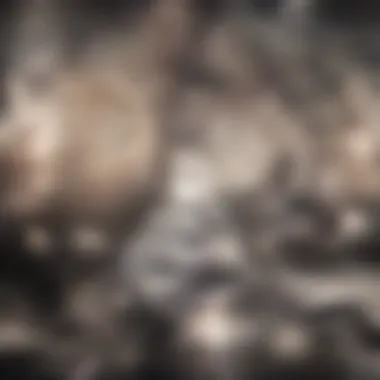Exploring the Depths of French Nouvelles: A Literary Journey


Intro
French nouvelles represent a significant genre that offers unique insights into the human experience. Originating in a rich tapestry of cultural and literary traditions, these narratives serve as more than mere stories. They encapsulate the ethos of their times, engage themes of identity, morality, and societal shifts, and invite readers into a reflective exploration of the world.
This article will guide readers through the historical significance of French nouvelles, tracing their stylistic evolution, impactful themes, and the key authors who have shaped the genre. We will explore how these narratives have influenced literature and culture, as well as the changing perceptions of readers over time. Understanding the nuances of French nouvelles enhances our appreciation for their relevance in contemporary discourse and their enduring legacy.
Artist Profile
Biography and Background
French nouvelles, or short stories, can be traced back to medieval France, deriving from the storytelling tradition preserved through oral history. This genre evolved significantly in the 19th and 20th centuries, with writers such as Gustave Flaubert and Guy de Maupassant making notable contributions. Their works often reflect the complexities of Parisian life and societal norms, exploring the intricate motivations of their characters.
The term "nouvelles" itself carries connotations of novelty, reflecting the genre's commitment to innovation in narrative form and theme. Throughout its evolution, French nouvelles have continually adapted, inviting engagement from various audiences.
Major Influences and Inspirations
Several factors have influenced the genre, including philosophical movements like existentialism and surrealism, which shape the thematic landscape of the narratives. The tumultuous historical periods in France, such as the French Revolution and both World Wars, also deeply affected the stories told in the nouvelles.
Notable authors like Honoré de Balzac, Marcel Proust, and contemporary voices continue to enrich this genre, drawing inspiration from their surroundings and personal experiences.
"The aim of art is to represent not the outward appearance of things, but their inward significance." - Aristotle
Narrative Themes
Identity and Existence
Identity is a recurring theme in French nouvelles, as characters often face existential dilemmas that prompt readers to reflect on human nature. The exploration of self in relation to society forms the crux of many narratives, highlighting internal struggles and societal pressures.
Love and Relationships
Another central theme involves the complexity of human relationships. Conflicted passions, betrayal, and yearning are often depicted, showcasing how love can both uplift and devastate individuals.
Morality and Ethics
Many narratives confront moral dilemmas. Characters are frequently placed in situations that compel them to choose between personal desires and ethical responsibilities.
By understanding these themes, readers can appreciate how French nouvelles serve as a mirror for societal values and individual challenges, revealing deep truths about the human condition.
Legacy and Contemporary Relevance
The legacy of French nouvelles is profound. They have influenced countless writers and other art forms. The essence of these narratives is mirrored in modern-day short stories, films, and even digital storytelling.
As contemporary audiences engage with this genre, they find explorations of universal themes, resonating across time and culture.
Prologue to French Nouvelles
The exploration of French nouvelles is significant as it offers insights into a vital aspect of literary history. Nouvelles, characterized as short narratives that showcase intense storytelling, provide a glimpse into French culture and its artistic evolution. Understanding this genre enables readers to appreciate not only the technical craft of writing but also the underlying themes that resonate with societal issues and human experiences. This article aims to illuminate the nuances of these narratives by examining their origin, thematic evolution, and cultural impact.
Definition and Characteristics
French nouvelles are typically defined as short fictional narratives, distinguished from short stories and novellas mainly by their brevity and depth. Each nouvelle often centers around a singular event or moment, encapsulating the complexities of a particular situation or emotion.
Key characteristics of French nouvelles include:
- Conciseness: These narratives prioritize economy of language, packing profound meaning into fewer words.
- Character Focus: They often delve into the psyche of one or two main characters, exploring their motivations and conflicts.
- Open Endings: Many nouvelles leave readers with unresolved questions, reflecting the ambiguity of real-life situations.
- Themes of Human Experience: Common threads include love, betrayal, identity, and societal critique, mirroring the complexities of human interaction.
Historical Context
The historical landscape in which French nouvelles evolved is both rich and varied. Emerging primarily during the 19th century, these narratives were influenced by a range of social and literary movements.
In examining the historical context, several factors stand out:
- Societal Changes: The Industrial Revolution and the shifting social structures led to new themes in literature, including the examination of the individual’s place in society.
- Romanticism and Realism: The tension between these literary movements shaped the nouvelles. While Romanticism focused on emotion and individualism, Realism emphasized accurate representations of everyday life.
- Censorship and Freedom of Expression: Writers navigated these challenges, using nouvelles as a medium to critique societal norms without facing direct repercussions.
"Nouvelles serve not only as entertainment but also as a reflection of the dynamic cultural dialogues of their time."
Through a detailed lens on these aspects, the subsequent sections will further dissect the roots, evolution, and cultural resonance of French nouvelles, showcasing their importance in the literary canon.
Origins of Nouvelles


The concept of nouvelles is essential to understanding the evolution of French literature. Their origins can be traced back to both medieval culture and oral storytelling traditions. Exploring these foundations not only enriches our appreciation of the genre but also reveals how past influences continue to shape contemporary narratives.
Medieval Roots
Medieval literature was characterized by its themes of chivalry, morality, and the supernatural. The nouvelles emerged in a milieu where storytelling served various purposes—entertaining, educating, and moralizing. Authored predominantly in the 14th and 15th centuries, these narratives often reflected the complex social structures of the time.
A pivotal moment was the release of Les Cent Nouvelles Nouvelles in 1485. This collection presented a series of tales that featured intricate plots and character developments. This work illustrated the shift from the oral traditions to written forms, paving the way for more elaborate narratives. The themes of love, betrayal, and human folly tackled in these tales can be seen as precursors to the modern short story genre.
Additionally, during this period, storytelling became a communal activity. Gatherings would feature recitations of tales, enhancing the oral tradition. These narratives often observed social hierarchies, adding layers of complexity that resonate in modern writings.
Influence of Oral Traditions
The nouvelles owe much of their character to oral storytelling. The practice of reciting tales created a tradition of relatability. Each storyteller would infuse personal insights, leading to variations in the narratives. This flexibility encouraged themes of morality and human experience to take center stage.
In these oral formations, several elements became hallmark features of nouvelles. For instance, the interplay of dialogue and character interaction often began in these oral recitations. This characteristic remains evident today, where dialogue drives plot development.
Moreover, oral traditions provided a platform to transmit cultural values across generations. The tales spoke to universal human experiences—transitory love, moral dilemmas, and social consequences. Such elements resonate with readers even in modern contexts, as they reflect ongoing themes in literature.
"The storytelling traditions of the past form the bedrock upon which today's literary landscapes are built, illustrating the dynamic nature of narrative forms."
In summary, the origins of nouvelles can be found in a rich tapestry of medieval influences and oral traditions. By studying these roots, we can understand the genre's evolution and its lasting impact on contemporary literature. The narrative forms born from these origins continue to inform writers and inspire readers, demonstrating the enduring power of storytelling.
Evolution of Themes in Nouvelles
The evolution of themes in French nouvelles marks a significant aspect of the genre's development. This section focuses on how these themes have transformed over time and their relevance in social and cultural contexts. By examining themes such as Romanticism, social critique, and explorations of human experience, it becomes evident how these narratives provide insights into the complexities of human nature and society. The thematic evolution illustrates the shifting values and concerns of not only the writers but also of the societies from which they emerged.
Romanticism and its Influence
Romanticism emerged as a powerful movement in the late 18th and early 19th centuries, influencing many writers of the nouvelle genre. This period emphasized emotion, individualism, and a connection to nature. Many authors began to focus on the inner world of characters, exploring their thoughts and feelings with depth and sensitivity.
The prominence of nature as a theme reflects the Romantic ideal that beauty exists within it, often serving as a sanctuary for troubled characters. For instance, the works of authors like Gustave Flaubert illustrate profound emotional experiences linked to the natural world. The themes of longing and idealism in the context of personal relationships also became prominent.
Social Commentary
Social commentary represents another vital theme within the evolution of French nouvelles. As society grappled with issues like class distinctions, industrialization, and moral dilemmas, authors used their narratives to critique the status quo. This theme is particularly evident in the works of Guy de Maupassant, who often exposed the flaws of society and the darker side of human interactions.
Maupassant’s approach often involved a keen observation of daily life, wherein he infused his stories with elements of realism. By doing so, he pressed readers to confront uncomfortable truths. The social landscape in these narratives allows for discussions around the inequalities and injustices prevalent in the world at that time.
Human Experience and Emotion
The exploration of human experience and emotion is integral in French nouvelles, transcending the period in which they were written. The focus on personal relationships, existential dilemmas, and the intricacies of affection make these narratives profoundly relatable.
For many authors, capturing the essence of human emotions is key. This is seen in the poignant observations of love, loss, and identity that permeate their works. As a result, the reader can find fragments of their own lives reflected in the characters’ experiences, making these narratives timeless. This connection between readers and characters fosters a deeper engagement with the texts and enhances the broader cultural discourse surrounding them.
The evolution of themes in French nouvelles not only showcases literary innovation but also offers a mirror to society's changing dynamics and values over time.
Key Authors of French Nouvelles
The impact of French nouvelles on literature can hardly be overstate. This genre has produced a variety of influential authors who have shaped the narrative style and thematic approaches of modern storytelling. Focusing on key authors enables a deeper understanding of the nuances of these works and their lasting significance. Each author contributes distinct elements that enrich the overall narrative landscape. Their styles, themes, and character portrayals offer insight into the complexity of human experience, thereby enhancing the reader's connection to the stories.
Maupassant's Contributions
Guy de Maupassant stands as one of the foremost figures in the realm of French nouvelles. His work is characterized by sharp realism and a keen observation of social dynamics. Maupassant's ability to create vivid characters and intricate plots set a standard for the genre. He often explored themes of love, death, and the human condition, reflecting his belief that literature should capture the essence of life. Maupassant mastered the art of the short narrative, packing deep meaning into concise frameworks.
He is known for stories such as "The Necklace," where he delves into the consequences of pride and materialism. Here, the twist ending encapsulates a critical point about societal expectations and personal aspirations. His contributions are not only historical but also continue to influence contemporary writers. Maupassant's style encourages brevity yet demands depth, making his work essential in understanding the evolution of the nouvelle.
Voltaire's Perspective
Voltaire, while often recognized for his philosophical works, also made significant contributions to the genre of nouvelles. His approach blends satire with social critique, providing a unique outlook on the society of his time. In works like "Candide," he employs the narrative structure to challenge established norms and idiocies across various societies.
Voltaire's skillful use of wit and irony amplifies the themes of folly and optimism. Unlike many contemporaries, he wrote not just to entertain but to provoke thought. His concise tellings often serve a dual purpose, providing commentary on life through humorous lenses. Analysis of his narratives reveals a sophisticated understanding of character dynamics and philosophical dilemmas, showcasing how modern issues resonate even today.
Contemporary Voices
In recent years, the realm of French nouvelles has been revitalized by contemporary authors who draw upon the tradition while infusing modern themes. Writers like Amélie Nothomb and Muriel Barbery have contributed fresh perspectives. Their narratives address contemporary issues such as identity, isolation, and the complexities of relationships in this globalized world.
Amélie Nothomb's works, characterized by an often autobiographical style, explore personal and societal conflicts. Meanwhile, Muriel Barbery's narratives delve into philosophical inquiry within everyday settings, encouraging readers to question the ordinary. These authors not only preserve the essence of the nouvelle but expand its boundaries, catering to modern audiences.
As the genre continues to evolve, these contemporary voices reaffirm that the French nouvelle retains its relevance in literary discourse, reflecting changes in society while maintaining its core elements.
Literary Devices in Nouvelles


The exploration of literary devices in French nouvelles plays a significant role in understanding the depth and complexities of this genre. These devices serve to enhance narratives, drawing readers into the world crafted by the author. Through the clever use of language and structure, the reader can find a greater appreciation for the thematic elements and emotional undertones present in these stories. Literary devices not only shape the narrative flow but also contribute to character development and thematic exploration.
Narrative Structure
Narrative structure is foundational for any work of fiction, and in the context of French nouvelles, it is particularly influential. Most nouvelles follow a compact narrative form, often focusing on a singular incident or character. This concise approach allows authors to deliver powerful messages without unnecessary elaboration. Traditionally, the structure may include elements like exposition, conflict, climax, and resolution, although many nouvelles play with these elements.
One notable characteristic is the plot twist, which often serves as a climax in French nouvelles. Authors such as Guy de Maupassant are known for their skillful deployment of unexpected endings that recontextualize the entire narrative. This element not only keeps readers engaged but often prompts reflection on the moral complexities presented within the story.
In contrast to longer forms of literature, the brevity of nouvelles demands precision. Every sentence counts and must carry weight, often leading to a more thought-provoking experience for the reader. This can make the narrative structure of nouvelles feel both refreshing and intense.
Symbolism and Imagery
Symbolism and imagery are critical tools in the hands of the author, allowing for richer narratives. In French nouvelles, these devices offer layers of meaning that transcend the literal events of the story. Symbolism provides a way to convey complicated ideas and emotions more subtly. For example, a recurring object or motif may symbolize broader themes such as loss, love, or identity.
Imagery, meanwhile, serves to evoke sensory responses, making the narrative more vivid for the reader. Maupassant's stories, for instance, often contain detailed descriptions of settings that immerse the reader in the atmosphere. The portrayal of nature, city life, or domestic spaces deepens the emotional resonance throughout the narrative.
"In the realm of nouvelles, every detail can hold a universe of meaning, demanding active engagement from the reader."
Engaging with these elements encourages readers to look beyond the surface and interpret the text from multiple perspectives. Furthermore, the effective combination of symbolism and imagery can contribute to the overall tone and mood of the narrative, shaping how readers feel as they encounter the text.
By understanding the importance of literary devices in French nouvelles, one gains insight into how authors create compelling and memorable works. These elements not only enhance the reading experience but also contribute to the genre's lasting impact on literature.
Cultural Impact of French Nouvelles
Understanding the cultural impact of French nouvelles reveals how deeply woven these tales are in the fabric of literature and society. They are not simply stories; they represent a lens through which we can view the evolving nature of culture, identity, and morality. The nuances of French nouvelles shape and reflect societal changes, influencing various forms of art and expression. Their significance broadens when we consider their effects on film and theater, as well as their continued relevance in contemporary literature.
Influence on Film and Theater
The narrative structure of French nouvelles has significantly influenced film and theater. Many directors and playwrights have drawn inspiration from the concise storytelling style, adapting the profound themes and character complexities for the screen and stage. The transition from text to visual medium does not dilute the themes; instead, it enhances them by providing a unique interpretation.
For instance, films like "Les Misérables" have roots in literary works that echo the style of the nouvelles. The tight narratives, with their climaxes and unexpected endings, translate well into cinematic storytelling. The avenue of adaptation fosters a cultural dialogue, bridging the gap between reading and viewing experiences.
Moreover, theater productions frequently harness the emotional depth found in narratives, exploring human experiences and societal values. Renowned playwrights have adapted several nouvelles, navigating through the underlying tensions of the human condition. The intimate nature of nouvelles makes their themes ripe for exploration through performance art, creating a compelling overlap between literature and theater.
Nouvelles in Contemporary Literature
In modern literature, the influence of French nouvelles is palpable. Authors today continue to explore themes rooted in the novelle tradition. Topics like existentialism, identity crisis, and moral ambiguity remain prevalent in contemporary narratives.
Writers often employ the brevity of the nouvelles to convey complex emotions and thoughts succinctly. The compact storytelling allows readers to engage with the material on a different level. Unlike longer novels, the essence of a nouvelle can resonate profoundly in a shorter format, making it accessible yet impactful.
Furthermore, literary awards and festivals that celebrate short forms of literature often draw attention to the legacy of French nouvelles. They inspire writers to experiment with form, crafting narratives that reflect contemporary issues while respecting the quintessential characteristics of the genre.
The lasting cultural impact of French nouvelles is seen not just in their content, but in how they resonate across various artistic expressions, enriching the broader narrative landscape.
In summary, the cultural impact of French nouvelles extends beyond mere storytelling. They have significantly shaped film, theater, and contemporary literature, fostering an appreciation for short forms of artistic expression that continue to engage audiences worldwide.
Themes of Identity and Gender
The themes of identity and gender hold significant importance in the landscape of French nouvelles. These narratives expertly explore the complexities of human relationships and the societal constructs that shape them. By examining identity, the nouvelles provide an avenue to understand personal and collective experiences that define individuals within various contexts. Gender, similarly, serves as a lens through which to scrutinize the multifaceted nature of social roles and the tensions that arise from them.
Delving into these themes allows readers to connect with the characters on a deeper level, thereby enhancing emotional engagement with the text. Moreover, the insights garnered from these explorations resonate with broader social conversations, prompting discussions about equality, freedom, and the diversity of human experience. Ultimately, the synthesis of identity and gender within these narratives shapes a richer understanding of cultural dynamics.
Representation of Women
In many French nouvelles, the representation of women is nuanced and layered. Characters often reflect the changing social norms of their time. For instance, writers like Guy de Maupassant frequently depicted women grappling with their roles in society. These portrayals suggest a deep awareness of the struggles women faced, illustrating their desires, aspirations, and the constraints imposed upon them.
Women in these narratives are not merely passive figures; instead, they exhibit agency and complexity. They often challenge stereotypes, pushing back against patriarchal expectations. As a result, the exploration of female representation reveals the tension between individual identity and societal restrictions.
This intricate focus on women’s experiences aids in amplifying underrepresented voices and contributes to a broader understanding of gender dynamics. Today, these insights remain potent and relevant, resonating with ongoing discussions about women's rights and identity.
Exploration of Masculinity
Conversely, the exploration of masculinity in French nouvelles presents a contrasting yet equally compelling narrative. Male characters frequently embody the conflicting ideas of strength, vulnerability, and societal obligation. Often, the portrayal of masculinity reveals the emotional struggles that men face in the wake of societal expectations.
Works from authors like Honoré de Balzac highlight how male characters navigate their identities against a backdrop of competition and honor. These narratives invite readers to confront the societal pressures that dictate masculine behavior, encouraging a reflection on what it means to be a man in different contexts. The exploration of masculinity thus fosters a critical examination of power dynamics and self-image, challenges traditional notions of male strength, and underscores the importance of emotional depth.
Ultimately, the themes of identity and gender within the French nouvelles create a rich tapestry of human experience. They reflect the complexities of societal roles, offering invaluable insights into the personal and lasting impact these narratives have on readers. Whether they reflect on the struggles of women or the expectations placed upon men, these stories contribute to an evolving dialogue on identity in contemporary society.
Reader Reception Over Time
The reception of French nouvelles exposes the evolving relationship between literature and its audience. Understanding reader reception is crucial as it reflects cultural shifts, societal values, and changing tastes over time. The concept of how a literary work is received indicates not only the aesthetic qualities of the text but also its relevance in broader discourses.


Often, the reception of a genre like the nouvelle hinges on how it resonates with its context. For instance, readers' responses can be analyzed through critical reviews, public discussions, and academic discourses. This section will explore two relevant aspects of reader reception: critical acclaim and public perception.
Critical Acclaim
Critical acclaim showcases the esteem that literary works and authors achieve within literary circles. Many French nouvelles received praise from the critics of their era. For example, Guy de Maupassant is often hailed as a master of the form, with his stories noted for their innovation and psychological depth. His work exemplifies how skillful narrative construction can lead to recognition and enduring impact.
Some notable contributions to critical discussions include:
- Exploration of themes such as existentialism.
- Innovative narrative styles and techniques.
- Relevance within the broader literary canon.
Critics often highlight the technical mastery in short narratives. They dissect aspects like pacing, character development, and climax. Because of such analyses, stories gain a place in academic syllabi, fostering ongoing dialogue about their worth and influence on future writers. Indeed, attention from critics lends a form of legitimacy to the genre, reinforcing its cultural significance.
Public Perception and Popularity
Public perception is equally important, as it captures the immediate responses from the broader audience. The popularity of French nouvelles can be traced through various media, including newspapers and magazines of the time. Public engagement can often serve as a testament to the story’s resonance. For instance, stories that sparked debates may have revealed underlying societal tensions or aspirations.
- Themes of love, morality, and the human condition often resonate prominently with readers.
- The accessibility of these narratives allows a wider audience to engage with complex issues in a manageable format.
- Serialization of nouvelles in publications also contributed to their popularity, making literature available to the casual reader rather than just the elite.
The engagement with the audience has indicated the narratives' ability to connect with shared experiences. This connection fosters a sense of community among readers and bridges gaps across generations.
As the genre evolved, so did reader preferences. Changes in societal norms and values shaped what themes and styles became favorable. Thus, examining reader reception over time offers a lens through which the impact and relevance of comme bourgeoning genre can be understood.
Comparative Analysis with Other Genres
The comparative analysis of French nouvelles provides a useful lens through which to appreciate their unique characteristics and nuances. By positioning them alongside other literary forms like short stories and novellas, we can uncover both distinctions and overlaps, enriching our overall comprehension of the genre. Understanding these relationships can illuminate the evolution of narrative techniques and thematic explorations across diverse literary landscapes.
Contrasts with Short Stories
When comparing French nouvelles to short stories, several notable differences arise. Short stories tend to be concise and have a particular focus. They often center on a single theme or emotion, aiming for a swift impact on the reader. In contrast, French nouvelles allow for a bit more exploration. While they may also be brief, they open the door to a broader range of characters and conflicts. This flexibility enables writers to weave intricate plots that may not fit neatly in the shorter format.
Furthermore, in terms of structure, French nouvelles can exhibit greater complexity. They may contain multiple narrative threads, allowing for deeper character development and subplots. In doing so, they provide the reader not just a quick snapshot but a more comprehensive glimpse into the world being depicted. This aspect adds richness and depth often absent in typical short stories.
Similarities with Novellas
Aside from their differences with short stories, French nouvelles share several similarities with novellas. Both forms typically occupy a similar narrative space, being longer than short stories but shorter than full-length novels. This shared length suggests a commitment to explore themes more thoroughly than a short story might allow, while still retaining brevity and focus compared to a novel.
Moreover, both French nouvelles and novellas often prioritize character-driven plots. They delve into the human condition, exploring broad themes such as love, society, and morality. This examination often leads to a resolution that prompts reflection. Readers of both genres can often engage deeply with characters’ inner lives, fostering empathy and understanding.
The Future of Nouvelles
The future of French nouvelles holds both challenges and opportunities in an ever-evolving literary landscape. This section examines how changes in technology, reader preferences, and cultural shifts influence the development of nouvelles. As readers seek more engaging, accessible content, understanding these trends becomes essential.
Digital Transformation
Digital transformation is a significant factor affecting the future of French nouvelles. With the rise of the internet and digital publishing platforms, the way literature is consumed has drastically changed. Readers now access content through e-books, online magazines, and social media, which influences the format and style of nouvelles.
Candidates for digital adaptation find success in their ability to engage audiences with varied preferences. For instance, concise narratives work well for mobile reading and quick consumption. Online platforms like Wattpad and Kindle Direct Publishing allow authors to reach wider audiences, regardless of traditional publishing barriers. This inclusivity fosters diverse voices in the genre that may not have had exposure in the past.
Furthermore, digital tools enhance storytelling techniques. Features such as hyperlinks and multimedia elements enable authors to create immersive experiences, enriching the narrative. These tools prompt readers to interact with the text in ways not previously possible, balancing traditional narrative techniques with modern engagement strategies.
Emerging Narratives
Emerging narratives in French nouvelles showcase innovative themes and perspectives. Contemporary authors often tackle social issues, personal identity, and genre-blending, reflecting modern society's complexities. These fresh narratives challenge conventional storytelling and resonate with new generations of readers.
Writers are now exploring unconventional formats, such as interactive stories and hybrid genres, which suggest a departure from classic structures. This evolution is driven by a desire for authenticity in storytelling. Authors address topics like mental health, migration, and technology's impact on life, promoting deeper connections with the audience.
As society continues to evolve, so does the collective consciousness reflected in literature. Nouvelles will likely adapt to address these changes, further solidifying their relevance. The potential for innovative storytelling, combined with evolving media formats, offers a promising future for the genre.
The transformed landscape of literature demands new narratives that are reflective of contemporary issues, ensuring the enduring relevance of the French nouvelles.
Epilogue
In discussing the genre of French nouvelles, we come face to face with a narrative form that holds substantial weight in literary tradition. This conclusion serves as an essential capstone to our exploration, encapsulating the insights gained throughout the article.
Summary of Key Points
Throughout the various sections, we have unraveled the nuances of French nouvelles, illuminating their:
- Historical Significance: Understanding how these narratives evolved from medieval roots.
- Thematic Depth: Engaging with recurring motifs such as identity, emotion, and social commentary.
- Notable Authors: Highlighting the contributions of figures like Guy de Maupassant and Voltaire.
- Cultural Impact: Acknowledging their influence on modern literature and other art forms.
- Reader Engagement: Investigating how public perception and critical acclaim have shifted over time.
- Future Prospects: Considering how digital transformation presents new opportunities for the genre.
This summary emphasizes how these elements make the French nouvelles not just relevant, but a rich subject for ongoing discourse.
Final Thoughts on the Genre
The enduring allure of French nouvelles lies in their ability to capture the complexity of human experience within compact narratives. They serve as a mirror reflecting changing social norms, values, and identities. For both scholars and casual readers, this genre offers a gateway into understanding broader cultural dynamics. Furthermore, as writers continue to experiment with this form, we can anticipate an exciting evolution of narratives that resonate with future generations. In a world increasingly defined by digital storytelling, French nouvelles will likely see resurgence, encouraging new voices and perspectives within this classical framework.
As we move forward, it is crucial for readers to engage with these texts, not merely to appreciate their literary beauty but also to explore their historical contexts and contemporary relevance. This engagement fosters a deeper understanding of not only French literature but also the shared human experience they endeavor to portray.







